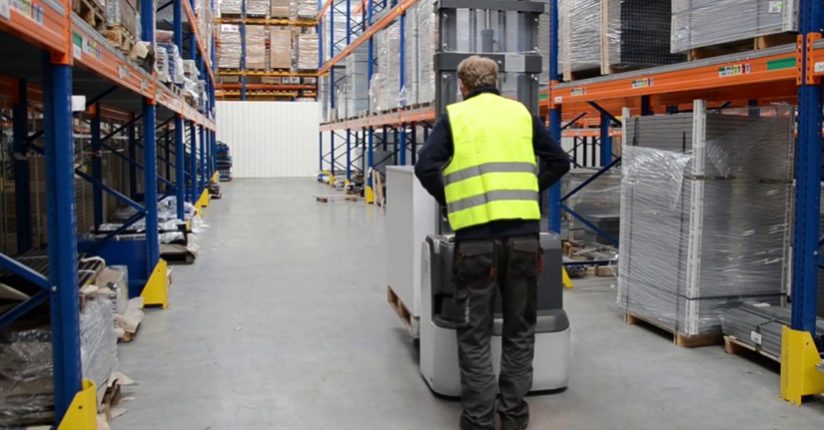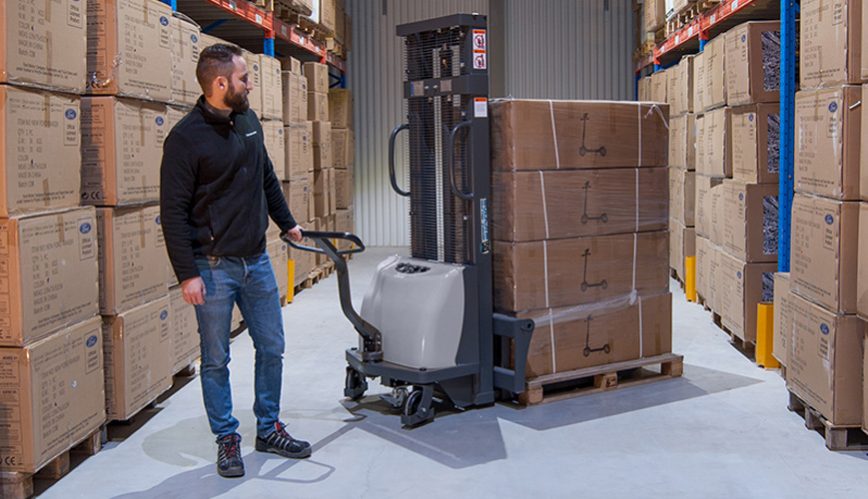Stackers – Applications, Types, and Benefits
The counterbalanced forklift is one of the most widely used and versatile pieces of equipment found in warehousing, logistics and manufacturing applications. However, there are a number of situations where using a forklift is either unnecessary or not practical. Whether it’s in a narrow aisle application, tighter confines or a lower intensity application, walk-behind stackers are often used as a sensible and cost-effective replacement whenever a forklift isn’t feasible.
The Benefits of a Stacker
Also known as a pallet or straddle stackers, this class of equipment offers a number of advantages over counterbalanced forklifts in applications with space restrictions due to their compact and maneuverable designs. The improved maneuverability of these models is generally achieved by replacing the large counterweights used in a sit-down counterbalanced forklift with a set of stabilizing outriggers. These outriggers, which are more commonly known as straddle legs, extend from the front of the machine to prevent it from tipping forward while lifting a load. This substantially reduces the amount of space needed to use these units in the smaller confines of many indoor material handling applications.
While their size and maneuverability is a key selling point for walk-behind stackers, their appeal goes beyond technical characteristics such as overall length and turning radius. To begin with, these units are significantly less expensive than traditional forklifts and often cost anywhere from 10-50% as much as a comparable forklift. And, as AC electric units with fewer moving parts than either electric or IC forklifts, these units also cost less to maintain and operate. Finally, they can also reduce your overall labor costs as the walk-behind models are not only easy to use but they can also be operated without specialized certification.
The Variations on a Stacker
While the most common type of stacker is what’s known as a walk-behind straddle stacker, there are actually number of variations on this general archetype, each designed for a variety of applications. For the most part, these variations are differentiated from each other on the basis of how they lift or distribute a load. Overall, there are 5 basic stacker types. These include the following: manual straddle stackers, straddle stackers, walkie reach stackers, forkover stackers and counterbalanced stackers. Let’s take a look at each type in further detail below:
Straddle Stacker
The most common type of stacker are electric walkie straddle stackers. As mentioned above, these units utilize straddle legs to stabilize the unit while lifting a load. Not only do these straddles help to balance the unit, but they also allow the stacker to get right up next to a pallet before picking it up and reduce the amount of space needed overall. When used in applications that include racking, a gap must be left at the bottom of the racking system for the straddles to slide underneath. Their overall cost and compact design has led to their proliferation in applications including retail, logistics, warehousing and manufacturing. At Starke, our electric straddle stackers are available in 2,000, 3,000 and 3,500 lb. units, including a 3,500 lb. unit that includes a fold-down platform for higher volume or longer distance applications.
Walk-Behind Manual Stacker
The least expensive and most straightforward stacker models available, manual and semi-electric straddle stackers are ideal entry level lifts for first time buyers. With either manual (hand or foot operated lift pump) or power assisted lift functions, these models are perfect for low volume, frequency and distance applications due to their low total cost of ownership and ease of upkeep and maintenance.
Among the most common uses of a manual straddle lift, like our LiftMaxx MSA3300X, are in smaller retail operations, where they prevent difficult and potentially harmful activities such as hand-bombing while saving hundreds to thousands of dollars in tailgate fees whenever trailers are loaded/unloaded without the aid of a drop-down tailgate. The same is true with our semi-electric straddle lift (the LiftMaxx EMSA3300X), however, since it has power-assisted lift functions, it offers increased productivity and ease of use relative to its fully manual counterpart.
Walk-Behind Reach Stacker
Walkie reach stackers take the concept of a straddle stacker and adds what’s known as a pantographic scissor mast. This specialized mast allows a walkie reach truck to extend its forks and carriage forward into a racking system to pick up a load from a distance. The ability to reach forward from the unit lets the walkie reach function in situations where a straddle stacker can’t be used. This is particularly true in lower volume applications where the speed of a rider reach truck would not be fully realized, making the walkie reach truck a great lower cost alternative. Our LiftMaxx walkie reach stackers are available from 3,000 – 4,000 lb. in capacity in single or double reach models.
Forkover Stacker
Forkover stackers are fairly similar to straddle stackers with the exception of the position of their outriggers. As the name somewhat suggests, the outriggers are positioned directly in-front of the unit and slot into a channel in the bottom of the forks (i.e., fork over outrigger). This alteration reduces the turning radius of the unit but comes with a significant limitation – forkover units can only be used with bottomless European-style pallets or bottomless bins. If a forkover stacker was used with a standard pallet, the forks and outriggers would pull the pallet apart as it was lifted upward. Looking for a forkover stacker, talk to your local Stärke dealer about our LiftMaxx ES35XE.
Counterbalanced Stacker
Unlike the other units listed above, counterbalanced forklifts do not utilize stabilizing outriggers. Similar to a counterbalanced forklift, these stackers position a heavy weight at the rear end of the unit to offset the weight of the load and maintain stability. The main advantage of a counterbalanced stacker is their ability to facilitate higher lifts than straddle or forkover stacker models, making them a better suited for modern warehouses characterized by higher racks and narrow aisles. Check out our ES30CAX for more information on counterbalanced stacker.
In Closing
As you can see, stackers come in a number of styles and configurations. Each type of stacker is designed and manufactured to fit certain application types. As such, a thorough site survey and inspection should be completed before purchasing a stacker. If you need assistance determine what stacker best suits your needs and application, please contact us and we’ll direct you to your local authorized Stärke dealer.


